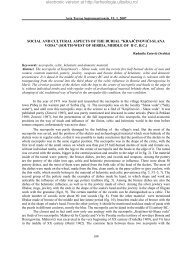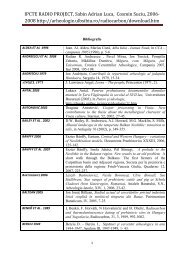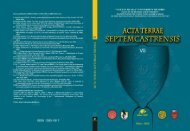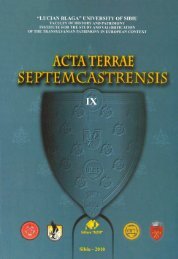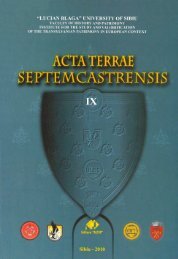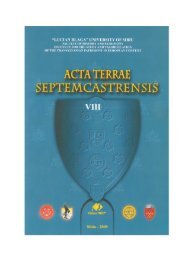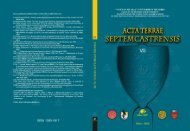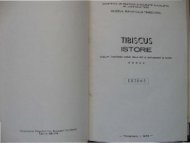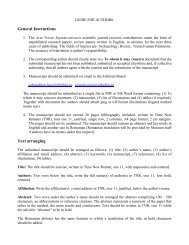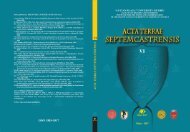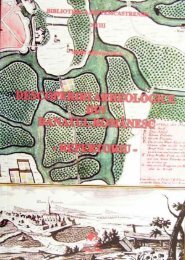acta terrae septemcastrensis viii - Institutul pentru cercetarea Åi ...
acta terrae septemcastrensis viii - Institutul pentru cercetarea Åi ...
acta terrae septemcastrensis viii - Institutul pentru cercetarea Åi ...
You also want an ePaper? Increase the reach of your titles
YUMPU automatically turns print PDFs into web optimized ePapers that Google loves.
Acta Terrae Septemcastrensis, VIII, 2009<br />
the evolution of the first stages of the Early Neolithic. This phase is characterized<br />
by a complex economy with dynamic agriculture, cattle and sheep farming,<br />
hunting and fishing, settlements made of surface dwellings (not only pit-houses),<br />
the development of pottery with complex shapes, such as cups and bucranium<br />
idols, and a variety of painting.<br />
During the Early Neolithic, the signs of the Danube script are concentrated<br />
in the Starčevo–Criş (Körös) cultural complex for 76.9% of the total occurrences<br />
(including data when the distinct Early Neolithic culture is not specified). The<br />
Starčevo–Criş (Körös) cultural complex was not only the incubator of the script,<br />
but gave a significant contribution to it clustering 7.1% of the total amount of signs<br />
of the writing system. Another prominent Early Neolithic culture, Karanovo I<br />
(Bulgaria), accounts for 8.4% of the total frequencies. Anzabegovo–Vršnik III, in<br />
F.Y.R.O.M., reaches 1.8%. Limited is the involvement of Banat I (1.4%) in<br />
Romania, Sesklo III (1.0%) in Greece and Danilo (1.0%) in Croatia. The input to<br />
the formative stage of the Danube script from the Gălăbnik group (0.7%), of<br />
Bulgaria, is narrow. Developing as a successful social reproduction strategy for the<br />
communities, the Danube script progressed in sync with a gradual increase in<br />
social complexity and interaction among micro-regional settlement systems.<br />
DatDas evidence connects the earliest stages of the Danube script to magicreligious<br />
liturgies and expressions of identity/affiliation. The sacral root is<br />
documented by miniaturized altars for worship belonging to the earliest stages of<br />
the Starčevo–Criş (Körös) (Paul 1990: 28, 1995, 2002 online; Gimbutas 1991: 313,<br />
figs. 8-9; Ciută 2001; Merlini 2004, 2005; Lazarovici Gh. 2006; Lazarovici and<br />
Gumã 2006) and Karanovo cultures. They possibly imitate the shape and<br />
inscriptions of monumental communitarian altars or shrines (Lazarovici C-M.<br />
2003: 86: fig. 1.7). The expression of identity/affiliation is rendered by seals<br />
ascertained to be the more or less contemporary with Starčevo-Criş (Körös) IIA<br />
(Banner 1935: 9, pl. VIII 3-4, 1942: 24-25, pl. XVI: 3-4; Kutzián 1947: 83, pl.<br />
XLVI, 3a-b; Makkay 1984: 28, fig. 101) and Karanovo I cultures (Georgiev 1967:<br />
97, fig. 17; Makkay 1984: 12-13; Kalchev 2005: 57; Lazarovici 2006: 341-366;<br />
Lazarovici and Lazarovici 2006). The twofold earliest occurrence of the script<br />
poses the possibility of a contrasting double function since its earliest phase―one<br />
in rituals, in order to support and convey communication with the divine sphere,<br />
and the other in daily life. Alternatively, are the seals carriers of magic-religious<br />
messages, too<br />
The pivotal role of the Vinča culture<br />
If the experiment with literacy started mainly in the Starčevo–Criş (Körös) and<br />
Early Karanovo communities, it was subsequently developed in the Early Vinča<br />
culture which became the main gravitational center of the Danube script. The<br />
Accumulative stage of writing was carried by polychrome and dark burnished<br />
pottery communities, which, in order of literate significance, are: Vinča A, A/B<br />
and B in Serbia and Romania; Starčevo–Criş (Körös) IIIB-IVA and IVA-IVB;<br />
Banat I in Romania; Alföld in southern Hungary; Karanovo III in Bulgaria; LBK I<br />
39



